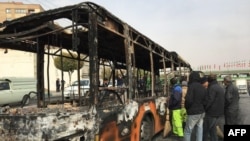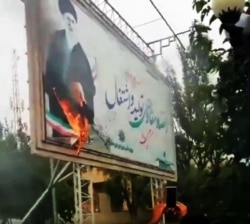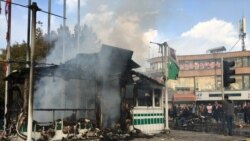The spokesman for President Hassan Rouhani’s administration claimed in a news conference on Monday morning that compared to the previous day there have been less protest demonstrations in Iran on Monday.
Meanwhile he claimed some demonstrators have used weapons during the previous days. Ali Rabiee, a former Intelligence Ministry operative, spoke as if he was reporting about a full war between the government and those who protest a sudden hike in the price of gasoline.
He also said that protesters took some security officers hostage but did not elaborate further. Meanwhile he declined to give away information on the casualty toll of the first three days of the protests.
However, reports compiled by journalists and observers following reports from various regions of the country indicate a minimum of 100 and up to 200 people killed.
The Islamic Revolution Guard Corps (IRGC) issued its first statement on the protests Monday, echoing what other senior officials have said about protests being fueled by the United States and Iranian opposition abroad. IRGC also vowed to use all means to restore order.
Demonstrations have been going on in Iran for the fourth day after the Iranian government increased the price of gasoline Friday morning. Security forces have used lethal force, with tens of people killed.
Despite an all-out clampdown on information, it appeared on Monday that the government's use of lethal force has so far failed to deter protesters.
In the meantime, Rouhani's threats against the demonstrators during a cabinet meeting on Sunday has further damaged his image. Rouhani warned the nation that they are being watched and identified by security forces by CCTV cameras everywhere. He said he has seen some films and there were "only a few" demonstrators.
The common point in remarks by Supreme Leader Ali Khamenei, Rouhani and Rabiee was their conspiracy theory about the involvement of foreigners in instigating the protests.
One or two economists accompanying Rabiee to the news conference acknowledged that the government had failed to convince the people prior to implementing the price rise.
But after four days, it is clear the protests have gone far beyond the gasoline price issue. Most of the demands voice and slogans chanted point to a complete rejection of the ruling establishment and the Islamic Republic system.
Furthermore, in the 4th day of protests, Iranian media began to disclose information about the large scale of arrests made during the past three days. They reported that in some larger cities "hundreds" of demonstrators have been arrested. Up to 60 have been arrested in Yazd, the reports said. The total number has been estimated as "more than a thousand."
Regardless of the relative transparency about the arrests, the government has attempted to conceal the number of deaths. For instance, while the government has acknowledged that one demonstrator has been shot dead in Behbahan, four families have come forward in that city announcing the death of their loved ones.
Also, in videos appearing on social media, regardless of the clampdown on the Internet, and rebroadcast by foreign-based Persian-language TV channels, people in Behbahan said more than four protesters have been killed in the city, some shot in the head.
Reports of shooting protestors in the head have also come from Shiraz and Shahryar. This might indicate the use of snipers, a tactic that was used in the 2009 protests and recently in Iraq, where it was attributed to Iranian-backed militia.
The governor of Eslamshahr in Tehran province has asked for assistance from security forces in other locations to control the situation.
Now it is feared that at least 40 people have been killed, based on various reports coming from citizens and rights groups.
Latest reports coming from Iran indicate serious clashes in Isfahan Sunday evening and Monday morning in various neighborhoods.
Most of the fragmented reports come from videos aired on satellite TV and individuals phoning in to radio and TV stations.
Further protests have also been reported in Shiraz, Tabriz, Kermanshah and Shahryar. Dozens of banks, particularly the branches of IRGC-linked Ghavamin Bank have been set on fire, citizen journalists reported. Also, the government says many of its offices have been attacked and torched. Similarly, local offices of Friday Prayer Imams were attacked and set on fire.
Since Sunday, there have been an increasing number of reports about university students in Tehran, Isfahan and Shiraz lending further momentum to the protests. Meanwhile the arrest of some labor activists including Sepideh Qolian in the demonstrations indicate social groups may have joined the protests.
Groups of Iranians living in European capitals have been gathering in front of Iranian embassies and consulates voicing their protest to the regime's harsh treatment of demonstrators.
In the meantime, most Iranian news agencies that seemed dormant on Saturday and part of Sunday have come back on line with reports saying the situation has calmed down. On the contrary, Iranian newspapers appear to have got the go-ahead to report the protests, but most of their reports attempt to portray the protesters in a bad light in line with Khamenei's comment on Sunday that they were "a bunch of thugs."
The Internet remains shut, with 93 percent of traffic down, while users are trying to find their way around the clampdown. Late Sunday and on Monday, an increasing number of videos on demonstrations have been published online.








